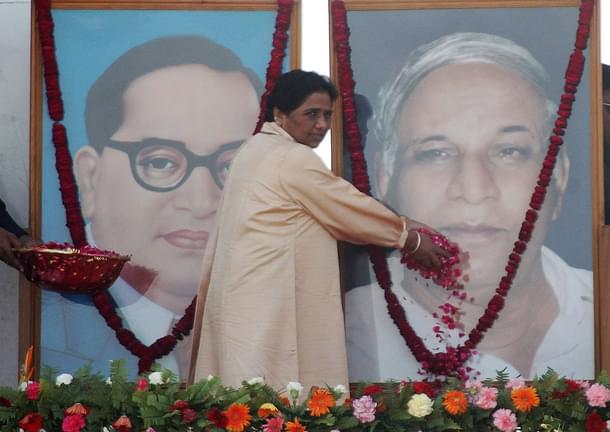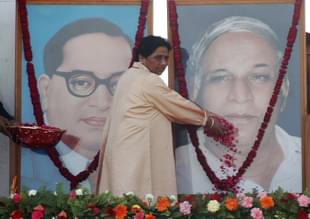Politics
Mayawati: Spent Force Or Dark Horse?
Dr A.K Verma
Jun 27, 2016, 03:16 PM | Updated 03:16 PM IST
Save & read from anywhere!
Bookmark stories for easy access on any device or the Swarajya app.


Last week’s resignation of Swami Prasad Maurya, the national General Secretary of the Bahujan Samaj Party (BSP) has brought back the spotlight on BSP chief Mayawati as Uttar Pradesh hits election mode.
Mayawati is an enigmatic personality. Building on Kanshi Ram’s Dalit organisations such as the All India Backward and Minority Communities Employees’ Federation (Bamcef) and Dalit Shoshit Samaj Sangharsh Samiti (DS-4), she ultimately assumed unrivalled leadership of the BSP.
Mayawati hogged the limelight in the 2007 UP assembly elections and surprised everyone by winning 206 out of 403 seats and terminating the era of fractured mandates. This achievement was significant because in 1993 and 1996, the BSP was stuck at 67 seats in the state assembly. Because the Dalits constitute 21 percent of Uttar Pradesh population, and presuming most of them voted for the BSP, she could have hardly done any better. It was then that Mayawati started thinking big and plunged into innovative social engineering.
She reached out to the lower backward class and the Muslims. In doing so, she took on her arch rival and former chief minister Mulayam Singh Yadav of the Samajwadi Party (SP). She succeeded and, in the next assembly elections increased her vote share, from 19.6 percent in 1996 to 23 percent in 2002, and took her seats tally to 98.
In the first-past-the-post (FPTP) electoral system (where one who earns the most number of votes wins) and multi-cornered contests among the Congress, Bharatiya Janata Party (BJP), SP, and BSP, any vote share around 30 percent was good enough to win the majority in UP. Mayawati knew that she needed just seven percent more votes as compared to what she got in 2002 to form the majority government.
She approached Brahmins, who are roughly seven percent of the population, and told them that together with the Dalits, they could be in power. If they joined the BSP, they would be given their due share in party and government.
Mayawati made Satish Mishra (Brahmin) her ambassador. He organised Brahmin jodo sammelans (Brahmin enrolling conferences) in districts to attract Brahmins. She did not stop at that; she was keen to build a rapport between the Brahmins and the Dalits. So, she took another innovative step by forming the Brahmin-Dalit bhaichara banaao samiti (Brahmin-Dalit goodwill committee).
The composition of this samiti was interesting. It was an all-Brahmin committee, except the secretary, who was Dalit. The secretary would arrange meetings of the committee with the Dalits. He would choose a Dalit basti (village) and take Brahmins there. These were Dalit bastis where the Brahmins would not have gone before. The Dalits in turn shared foods, or exchanged ideas on politics and other matters.
The social engineering strategy of Mayawati, where she persuaded Brahmins to accept her as their leader and developed the Brahmin-Dalit rapport, was a masterstroke without parallel in independent India. She brought together two social denominations at the two extremes of the social spectrum and who were disconnected from each other socially. Mayawati’s strategy demonstrated how such social distances could be demolished.
An interesting logic behind her strategy was that between the Brahmins and the Dalits, there were no economic conflicts, only psychological disconnect. Once bridges were built between them, the disconnect would disappear, and the two would come together. And, as the 2007 poll results showed, from a 23 percent vote share in 2002, she reached 30 percent vote share in 2007. It was a significant difference; she had won 108 more seats, taking her seats tally to 206 and obtaining a clear majority.
However, Mayawati lost the 2012 assembly elections badly. Although she lost only 4.5 percent of the votes, it accounted for a substantial 126 seats. Interestingly, Akhilesh Yadav of the SP, who then became chief minister, won with just 29 percent of the votes, the lowest vote share on which any government has formed in UP.
Mayawati lost for two reasons. One, she completely neglected the consolidation of her social engineering project in UP. Two, she started focusing elsewhere in her drive for assuming bigger roles at the national level. It was a blunder for the BSP; one hopes that Mayawati learnt from her 2012 fiasco.
But, something very startling happened in 2014. Mayawati lost all her 20 Lok Sabha (LS) seats in UP, and her vote share went down to less than 20 percent. Besides, she lost her core constituency to the BJP, to whom the BSP lost 16 percent Jatav and 35 percent non-Jatav votes. It is likely that she transferred her Dalit votes to the BJP just to defeat Mulayam Singh Yadav’s aspirations of becoming prime minister.
But the crucial question now is: Will Mayawati be able to regain lost ground in the 2017 assembly polls?
The BJP is trying its best to retain its share of the Dalit vote through various measures at the government, party, and social levels. Given that many are inclined towards following the stock exchange model of political support (voting a party that promises maximum returns), one cannot be sure of Mayawati regaining all the Dalit votes that the BJP won in 2014.
The BJP’s inclusive politics, amalgamating development with an element of populism, is an attempt to retain Dalits and OBCs in its kitty. Should that happen, Mayawati may not be able to replicate her social engineering performance. The BJP is also following Mayawati’s model in attracting Brahmins. It has held a Brahmin sammelan (Brahmin meet) at Aligarh earlier this year, and plans more such meets in the future.
Additionally, to counter both the BSP and Congress, they may bring in a last-minute surprise Brahmin candidate, given the reluctance of Rajnath Singh (a thakur), to become the party’s chief ministerial candidate.
Caste and primordial identities in UP are still at play, and one does not know how much of these aspects has been diluted over the years. Given the interplay of caste, development, and inclusion in UP, it is hard to anticipate the outcome of in the coming electoral battle.
Whether there would be a complete reconfiguration of traditional constituencies or much of the voting would go on traditional primordial lines is very difficult to visualise at this stage. Because issues of leadership, selection of local candidates, and subtle micromanagement strategies are still in the making. But, all said and done, Mayawati is a dark horse in UP politics. The coming assembly polls in the state are an acid test of her resolve to win, as well as of her reputation. If she fails to replicate her social engineering strategy, it will mean the failure of BSP’s social strategy in UP but would also signal the start of her fall from grace among the Dalits.
A K Verma is Director, Centre for the Study of Society and Politics, Kanpur.





